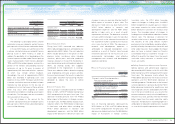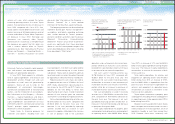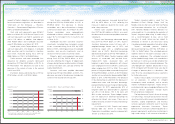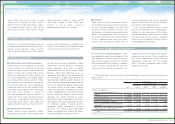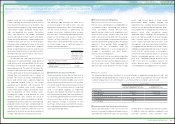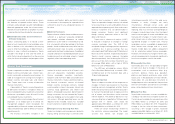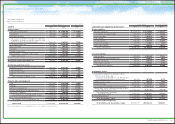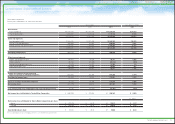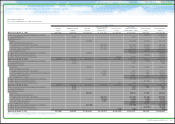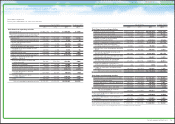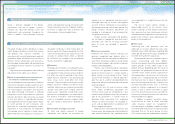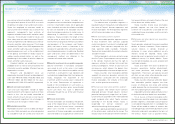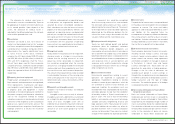Toyota 2011 Annual Report Download - page 69
Download and view the complete annual report
Please find page 69 of the 2011 Toyota annual report below. You can navigate through the pages in the report by either clicking on the pages listed below, or by using the keyword search tool below to find specific information within the annual report.
Market Risk Disclosures
0822
Financial Section and
Investor Information
Business and
Performance Review
Special FeatureMessage/Vision
Management and
Corporate Information
Toyota’s accounting policy is to record a write-
down of such investments to net realizable value
when a decline in fair value below the carrying
value is other-than-temporary. In determining if a
decline in value is other-than-temporary, Toyota
considers the length of time and the extent to
which the fair value has been less than the carrying
value, the financial condition and prospects of the
company and Toyota’s ability and intent to retain
its investment in the company for a period of time
sufficient to allow for any anticipated recovery in
fair value.
Toyota estimates whether future taxable income is
sufficient at a particular tax-paying component
and records valuation allowances to reduce
deferred tax assets when it is more likely than not
that a tax benefit will not be realized in the future
periods. Actual taxable income may differ from the
estimated amounts due to various assumptions
used to estimate future taxable income. If additional
valuation allowance is recorded due to lower actual
taxable income than estimated amounts it would
negatively affect future operating results.
Deferred Tax Assets
Marketable Securities and Investments in
Affiliated Companies
Toyota is exposed to market risk from changes in
foreign currency exchange rates, interest rates,
certain commodity and equity security prices. In
order to manage the risk arising from changes in
foreign currency exchange rates and interest
rates, Toyota enters into a variety of derivative
financial instruments.
A description of Toyota’s accounting policies
for derivative instruments is included in note 2 to
the consolidated financial statements and further
disclosure is provided in notes 20 and 21 to the
consolidated financial statements.
Toyota monitors and manages these financial
exposures as an integral part of its overall risk
management program, which recognizes the
unpredictability of financial markets and seeks to
reduce the potentially adverse effects on Toyota’s
operating results.
The financial instruments included in the
market risk analysis consist of all of Toyota’s cash
and cash equivalents, marketable securities,
finance receivables, securities investments,
long-term and short-term debt and all derivative
financial instruments. Toyota’s portfolio of deriva-
tive financial instruments consists of forward
foreign currency exchange contracts, foreign
currency options, interest rate swaps, interest rate
currency swap agreements and interest rate
options. Anticipated transactions denominated in
foreign currencies that are covered by Toyota’s
derivative hedging are not included in the market
risk analysis. Although operating leases are not
required to be included, Toyota has included
these instruments in determining interest rate risk.
Toyota has foreign currency exposures related to
buying, selling and financing in currencies other
Management's Discussion and Analysis of Financial Condition and Results of Operations
than the local currencies in which it operates.
Toyota is exposed to foreign currency risk related
to future earnings or assets and liabilities that are
exposed due to operating cash flows and various
financial instruments that are denominated in
foreign currencies. Toyota’s most significant
foreign currency exposures relate to the U.S.
dollar and the euro.
Toyota uses a value-at-risk analysis (“VAR”)
to evaluate its exposure to changes in foreign
currency exchange rates. The VAR of the
combined foreign exchange position represents
a potential loss in pre-tax earnings that was
estimated to be ¥148.9 billion and ¥107.6 billion at
March 31, 2010 and 2011, respectively. Based on
Toyota’s overall currency exposure (including
derivative positions), the risk during fiscal 2011 to
pre-tax cash flow from currency movements was
on average ¥96.5 billion, with a high of ¥107.6
billion and a low of ¥88.2 billion.
The VAR was estimated by using a Monte
Carlo Simulation Method and assumed a 95%
confidence level on the realization date and a
10-day holding period.
Toyota is subject to market risk from exposures to
changes in interest rates based on its financing,
investing and cash management activities. Toyota
enters into various financial instrument transactions
to maintain the desired level of exposure to the
risk of interest rate fluctuations and to minimize
interest expense. The potential decrease in fair
value resulting from a hypothetical 100 basis point
upward shift in interest rates would be
approximately ¥67.8 billion as of March 31, 2010
and ¥139.6 billion as of March 31, 2011.
There are certain shortcomings inherent to
the sensitivity analyses presented. The model
assumes that interest rate changes are
instantaneous parallel shifts in the yield curve.
However, in reality, changes are rarely
instantaneous. Although certain assets and
liabilities may have similar maturities or periods to
repricing, they may not react correspondingly to
changes in market interest rates. Also, the interest
rates on certain types of assets and liabilities may
fluctuate with changes in market interest rates,
while interest rates on other types of assets may
lag behind changes in market rates. Finance
receivables are less susceptible to prepayments
when interest rates change and, as a result,
Toyota’s model does not address prepayment
risk for automotive related finance receivables.
However, in the event of a change in interest rates,
actual loan prepayments may deviate significantly
from the assumptions used in the model.
Commodity price risk is the possibility of higher
or lower costs due to changes in the prices of
commodities, such as non-ferrous alloys (e.g.,
aluminum), precious metals (e.g., palladium,
platinum and rhodium) and ferrous alloys, which
Toyota uses in the production of motor vehicles.
Toyota does not use derivative instruments to
hedge the price risk associated with the purchase
of those commodities and controls its commodity
price risk by holding minimum stock levels.
Toyota holds investments in various available-for-
sale equity securities that are subject to price risk.
The fair value of available-for-sale equity securities
was ¥852.7 billion as of March 31, 2010 and
¥960.2 billion as of March 31, 2011. The potential
change in the fair value of these investments,
assuming a 10% change in prices, would be
approximately ¥85.3 billion as of March 31, 2010
and ¥96.0 billion as of March 31, 2011.
Equity Price Risk
counterparties or market, in estimating fair value in
the absence of quoted market values. These
estimates are based upon valuation methodologies
deemed appropriate under the circumstances.
However, the use of different assumptions may have
a material effect on the estimated fair value amounts.
Foreign Currency Exchange Rate Risk
Interest Rate Risk
Commodity Price Risk
69TOYOTA ANNUAL REPORT 2011


